is never released.
Change sides when satisfied that all items have been removed
from the side in which the search started. Without losing positive
control, the search man conducts the search on the other side of
the subject.
3-14
FM 3-19.15
18 April 2005
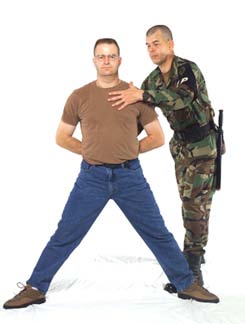
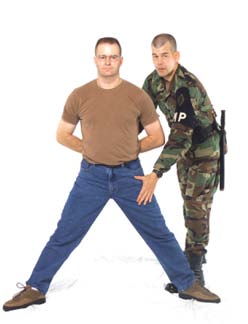
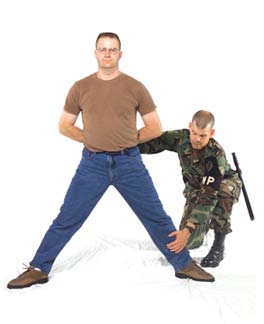
Apprehension, Search, and Detention
Figure 3-11. Performing the Standing Search
NOTE: Changing sides is accomplished by moving the outside hand
(the searching hand) to the subject’s uncontrolled handcuffed hand
located on the outside. The outside hand and forearm will cross over
the top of the reverse-handshake grip of the inside hand (see
Figure 3-12, page 16).
Crosses over the reverse-handshake grip with the outside hand
and grips the subject’s uncontrolled handcuffed hand in a
reverse-handshake grip.
Releases (quickly) the first reverse-handshake grip moving that
hand to the subject’s elbow as he sidesteps to the side yet to be
searched. The search man repeats the standing search technique
used on the first side of the subject.
Gives strong verbal commands and uses only the force necessary
to control the subject if he resists or becomes aggressive at any
time during the search.
Removes all items found during the search to be evaluated as
potential evidence or a weapon. Items not considered a weapon or
of evidentiary value will be returned to the subject at a later time.
Prone Search
3-33. Safety is the primary concern when dealing with a person under
apprehension. Therefore, the search man must protect himself by restraining
subjects under apprehension before conducting this search. Remember that
all subjects under apprehension have the propensity to turn violent or hostile.
That is the reason a prone search would be necessary. After performing an
arm bar takedown on a noncompliant subject, it is especially important for the search man to put him at a physical disadvantage to provide for the subject’s
safety and his own. By doing so, the subject’s ability to hide, destroy, or
remove any evidence is limited.
18 April 2005
FM 3-19.15
3-15
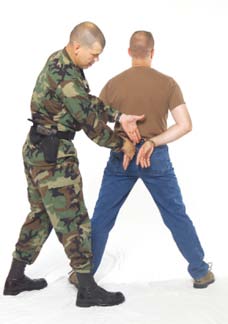
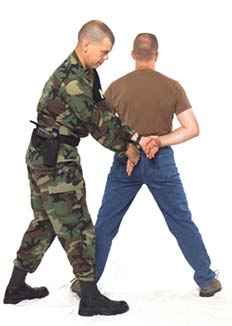
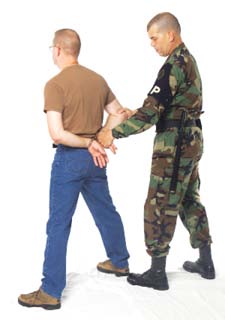
Apprehension, Search, and Detention
Figure 3-12. Performing the Standing Search (Changing Sides)
3-34. The safest way to handcuff or Flex-Cuf a noncompliant subject is in the prone position, when the search man has greater control of the subject. It is
usually the safest position in which to conduct a search
3-35. Handcuff the subject quickly during the apprehension. It is impossible
to predict what a subject will do when put under apprehension. Often a
subject may initially be cooperative and compliant; however, as the he
becomes aware of his situation, he may become overcome with emotion and
begin to struggle or pull away.
3-36. There is no legal or regulatory prohibition against opposite-gender
searches. Common sense prevails and whenever possible, searches should be
done by the same gender to avoid obvious questions and complaints. Once a
subject is at a physical disadvantage by cuffing and is more easily controlled, it affords the necessary time to get someone of the same gender there to
conduct the search.
NOTE: The subject is put into a physical disadvantage when he is
taken facedown to the ground using an arm bar takedown and cuffed.
z
During the preparation phase, the search man—
Ensures that the Flex-Cufs are not too tight.
Rotates his entire body around the subject’s shoulder and center
at the outside of the subject’s hip with his shin over the subject’s
shoulder and one knee on the ground. At least one knee should
remain over the subject’s back (near side), with the other on the
ground.
Pins the subject down by pressing his knee on the side of the
subject’s back or down on his closest elbow if resistance or
aggression is encountered. He simultaneously grips the subject’s
closest handcuffed hand, grabs it with a reverse handshake, and
applies pain for compliance.
3-16
FM 3-19.15
18 April 2005
Apprehension, Search, and Detention
Uses strong, forceful verbal commands, such as “Stop resisting,
stop moving around.”
Ensures that the subject’s feet and ankles are crossed.
CAUTION
Stay alert. If the subject uncrosses his feet and ankles, it is
usually a sign of preattack.
Removes all items found during the search so they can be
evaluated as potential evidence. Items not considered a weapon or
of evidentiary value will be returned to the subject at a later time.
z
During the performance phase, the search man—
NOTE: The search man must be systematic from head to foot while
conducting the prone search. If interrupted during the search, it is
important to start from the beginning to ensure that nothing is
missed. It is better to go over the same area two or more times than to
miss something that can be used as a weapon.
NOTE: The search man searches only one side (the front, back, or
side) of the subject at a time until that side is complete.
Divides the subject (visually) straight down the middle, using the
spine as the centerline.
NOTE: He does not cross this line while conducting the search.
Searches with an open hand, using a rub down or squeezing
method for best results. He does not just pat down the subject like
in the frisk search.
Works at an arm’s reach, searching only the area of the subject’s
body that is not in contact with the ground. The sense of touch, not
the sense of sight, is being used.
Stops the search as the subject’s knees are reached. He taps one of
the subject’s legs and firmly commands him to raise his foot up
and back, allowing for an inspection of the bottom of his foot. He
then searches from the knee to the ankle area. This is performed
on both the subject’s legs and feet.
NOTE: At this point, the entire back side of has been searched. What
remains to be searched is the front side of the subject (the chest and
front of the hips, waist, groin, and thighs).
Pivots back and faces the subject. Using the hand closest to the
subject’s head, the search man reaches across the subject’s back
and firmly grips the shoulder, rolling the subject up on the his side
toward him to expose the areas not yet searched.
Rolls the subject back down on his chest once all areas have been
searched.
18 April 2005
FM 3-19.15
3-17
Apprehension, Search, and Detention
3-37. The search man must be completely satisfied that he has found
everything. He must be especially sensitive to areas where weapons are often
concealed like the waistband, the small of the back, ankles, pockets, shoes, the tongue of the shoes, and the groin area.
NOTE: Before removing subjects from the area, a brief summary must
accompany them. The summary must include the subject’s name,
what he is suspected of doing, the time and date of the incident, and
who saw him do the action.
DETENTION
3-38. Civil authorities must provide adequate detention facilities for all
subjects. Authorities must be prepared to detain large numbers of people.
They may choose to expand existing detention facilities or set up temporary
facilities to accommodate the extra load. If possible, large-scale arrests are delayed until sufficient detention facilities have been set up.
3-39. If US military forces are committed to support local authorities,
commanders should coordinate with them to ensure that adequate detention
facilities are available and to learn their locations and capacities. If there are more detainees than civil detention facilities can handle, civil authorities may ask the military to provide support by setting up and operating temporary
facilities. Army correctional facilities cannot be used to detain civilians. A temporary military detention facility can be set up if—
z
Federal troops have been employed according to provisions.
z
The TF commander has verified that available civilian detention
facilities can no longer accommodate the number of prisoners awaiting
arraignment and trial by civil courts.
z
The Army Chief of Staff has granted prior approval.
3-40. Use of the temporary facility ends as soon as civil authorities can take custody of the detainees. Military forces are responsible for the custody,
health, comfort, and sustenance of all detainees in their facilities until custody is transferred to civil authorities. Temporary facilities cannot be used to
confine people arraigned or convicted in civil courts.
3-41. Women are detained in their own facility. Temporary facilities are
supervised and controlled by officers and NCOs trained and experienced in
military correctional operations. Females guard females. If two female guards
are unavailable, use two male guards or one male and one female guard (see
FM 3-19.40).
3-42. The same operational procedures that apply to the management of an
installation confinement facility (see FM 3-19.40) apply to the management of temporary detention facilities, except for training, employment, and
administrative discipline. Guards and support personnel under direct
supervision and control of military officers and NCOs need not be trained or
experienced in military correction operations. They must be specifically
instructed and closely supervised in the proper use of force, custodial
procedures, and the completion of military and civilian forms and reports that may be used. Soldiers that may be tasked to operate a temporary detention
3-18
FM 3-19.15
18 April 2005
Apprehension, Search, and Detention
facility should be familiar with the forms and reports used for civilian
apprehensions too.
3-43. Temporary facilities are set up on the nearest military installation or on suitable property under federal control. Ideally, the facility should be close enough to the disturbance area to minimize transportation and escort needs.
However, it should be far enough away not to endanger those being detained.
Whenever possible, existing structures are adapted for this use, but
construction may be needed to provide segregation for ensuring effective
control and administration.
3-44. The basic structure must include the following:
z
Search areas.
z
Holding areas for incoming men and women.
z
A processing area.
z
Holding areas for men and women who have committed
misdemeanors.
z
Holding areas for men and women who have committed felonies or are
violent.
z
A holding area for detainees’ property and evidence obtained during a
search.
z
A holding area for administrative support and records.
z
A medical station.
z
Latrines.
For more information on these structures see FM 3-19.40.
3-45. Facility personnel must ensure that proper sanitation is maintained.
When large numbers of people are detained or processed through a facility,
sanitation becomes a problem. Medical personnel must conduct regular health
inspections to detect unsanitary practices and conditions.
3-46. Facilities must be organized for a smooth flow of traffic. Processing
stations must be set up so there is a linear or circular sequence of movement.
These stations are set up out of sight of the holding areas. If possible, they are separated by a door to reduce noise. To reduce distractions, each station may
be partitioned. Detainees may be more cooperative if they are out of sight of
each other.
3-47. Injured people are given prompt medical treatment and transportation
to medical facilities when necessary. A medical aid station for screening
detainees and treating minor injuries is set up inside or next to the detention facility. Treatment areas, however, must be out of sight of the processing and holding areas. If possible, access to the medical facility bypasses the holding and processing areas. Facility personnel may also consider setting up a
separate holding area for injured detainees.
3-48. Detention facility operation plans must contain emergency procedures.
As a minimum, the following areas must be addressed:
z
Fire evacuation.
z
Disturbance control.
z
Facility security.
18 April 2005
FM 3-19.15
3-19
Apprehension, Search, and Detention
NOTE: Depending on the situation, other emergency procedures may
be needed.
3-49. Upon arrival at the detention facility, the detainee is logged in and
searched, regardless of whether a complete search has already been conducted
by the apprehending team in the field. Separate search areas are set up for
men and women. Weapons, contraband, flame-producing devices, suspected
evidence, money, and high-value items are confiscated. Medications are also
confiscated. Medical personnel screen detainees that have had medications
confiscated. Receipts are provided for any property or evidence that is
confiscated. Confiscated items are tagged, and the items are stored in a
controlled-property area.
3-50. As a detainee is brought to the facility, a file is initiated. Assigned detainee case numbers are used on all paperwork, such as logs, evidence tags,
reports, and visual documentation. All paperwork (including photographs)
that began outside the detention facility is marked with the case number.
Facility personnel may also use hospital identification tags. Using indelible
ink, the case number is written and attached to the tag on the detainee's
wrist. Different colors may be used to identify different subject classifications, such as misdemeanors, felonies, or violent offenders. If opposing factions are involved, procedures are established to ensure that members of opposing
factions are not processed together or detained in the same holding area.
3-51. After a detainee has been searched and classified, he is taken to a
processing station where his paperwork is processed. If subjects passively
resist by going limp, they may be moved by wheelchair. This reduces the
number of escorts needed and the fatigue to facility personnel. Paperwork is
reviewed to ensure that all information is complete, including charges,
witnesses, and reasons for the apprehension.
3-52. Equipment such as height charts, scales, fingerprinting equipment, and
cameras must be available for completing the police report and identifying the subject. Detainees may use aliases and not carry identification, so pay special attention to obtaining as much information as possible about the detainee's
physical characteristics.
3-53. After processing is complete, the detainee is placed in the appropriate holding area. Paperwork for the detainee is forwarded to the administrative
section. Files are reviewed for completeness and to determine the disposition
of the detainee. Information from the file may be placed in a computer to find repeat subjects. Computers may be used to file criminal information only.
3-54. Custody transfers and release procedures must be coordinated with civil authorities and the appropriate legal counsel. Every effort must be made to
arraign subjects quickly. The purpose of a detention facility is not to keep
people off the streets, but to aid in processing subjects through the legal
system. To speed up the release process, planners should consider issuing
citations or subpoenas for minor offenses.
3-55. Military force members may have to respond to writs of habeas corpus.
Writs are court orders addressed to a prisoner's custodian. Such a writ directs the custodian to bring the prisoner to court to determine the legality of the
3-20
FM 3-19.15
18 April 2005
Apprehension, Search, and Detention
prisoner's apprehension and detention. Custodians must ensure that all
documentation concerning the case is brought to court with the detainee.
3-56. Military personnel must obey writs issued by federal courts. For writs
issued by a state court, the custodian or his legal advisor should respectfully reply that US authority is holding the prisoner. The Office of the SJA can
answer any questions and explain the correct procedures.
18 April 2005
FM 3-19.15
3-21
This page intentionally left blank.
Chapter 4
Riot Shield and Riot Baton Techniques
A soldier may be required to be part of a riot control formation where his
primary weapon is a riot baton and his only protection a riot shield. A riot
baton in the hands of a well-trained soldier is an invaluable weapon in a
crowd control situation and may also be the most appropriate weapon. A
riot baton is a very versatile weapon that can be used as an offensive
and/or defensive weapon. The riot shield offers protection from the top of
the head to just below the knees.
OVERVIEW
4-1. Use of the riot baton and riot shield is based on METT-TC and the
commander’s choice-of-force option. Formations committed to a riot with riot
batons must have lethal overwatch, lethal weapons, and NLW employed
within the formation and reserve forces with additional NL and lethal
capabilities. These forces are positioned to rapidly reinforce the control force formation.
4-2. During the termination phase of the disturbance (when the violence has
subsided and is expected to remain that way), soldiers are placed in a
defensive posture. They may be equipped with a riot shield and a riot baton to perform their tasks. The riot shield is primarily a defensive weapon, which
may be used in an offensive mode. It is primarily used as an offensive weapon
when the formation is in close contact with rioters. The riot baton can also be used when formations are on the offensive and in contact with the crowd.
However, crowd control elements employed with riot shields and riot batons
must have lethal weapons and NLW available.
WARNING
Riot control formations are never employed with riot
shields and riot batons only. There must always be lethal
overwatch elements in position and lethal and NL
capabilities within the riot control formation with a ready
reserve force armed with lethal and NL capabilities.
RIOT SHIELD
4-3. In the hands of a properly trained soldier, the riot shield has proven to be the first line of defense for a formation. The riot shield may be used as an
offensive weapon when in contact with an aggressive crowd.
4-4. The riot shield may be held with one arm. It is secured to the weak side arm with a self-sticking strap system and a handle. This system is designed to 18 April 2005
FM 3-19.15
4-1
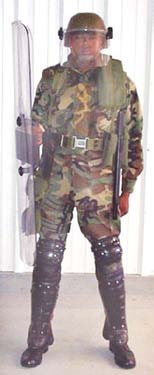
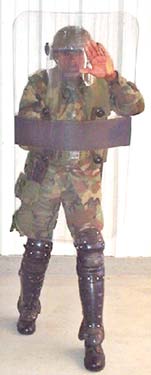
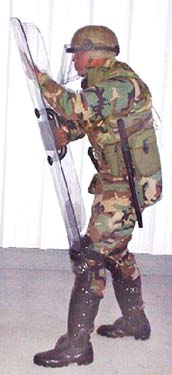
Riot Shield and Riot Baton Techniques
make the riot shield an extension of the soldier’s arm. The riot shield is held at a slightly inward angle. This allows for debris thrown at the soldier to fall
harmlessly to the ground (see Figure 4-1).
At the Ready
On Guard
On-Guard Profile
Figure 4-1. Riot Shield Positions
RIOT SHIELD CARRIES
4-5. The two basic riot shield carries are as follows:
z
At the ready. The at-the-ready position is used while in a column
formation or on the move toward hostilities. This position is designed
for rapid movement. It should not be used when in contact with a
crowd.
z
On guard. The on-guard position is used when the riot control
formation is in contact with the crowd or contact is eminent. It is used
primarily in the following formations:
Line.
Wedge.
Echelon.
Diamond.
Circle.
DEFENSIVE AND RETENTION TECHNIQUES
4-6. The primary purpose of the riot shield is for defense. However, each riot shield holder must be proficient in riot shield retention techniques.
4-2
FM 3-19.15
18 April 2005
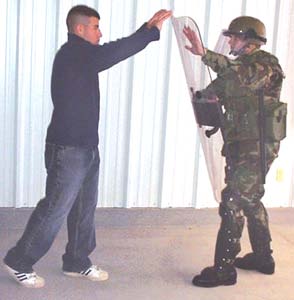
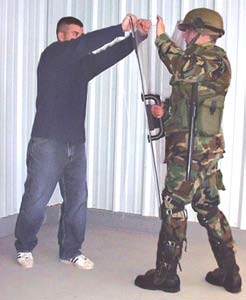
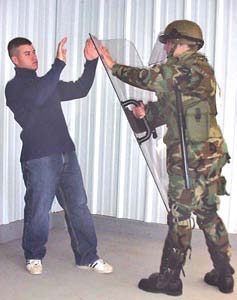
Riot Shield and Riot Baton Techniques
DEFENSE
4-7. The first line of defense for the formation is the riot shield. It is designed to withstand strikes from objects thrown by the crowd. In addition to
protecting the riot shield bearer, it also protects other members of the
formation from thrown objects.
RETENTION
4-8. When the control force is in contact with the crowd, the crowd will
attempt to strip the riot shield from the bearer. When a subject grabs the top
of the riot shield (see Figure 4-2), the riot shield holder slaps the riot shield with his strong hand near the subject’s hands and gives the following
commands (while continuing to slap the riot shield until the subject releases
it):
z
“Get back.”
z
“Get away.”
z
“Stop.”
Figure 4-2. Riot Shield Retention Technique (Top Attempt)
4-9. If t















